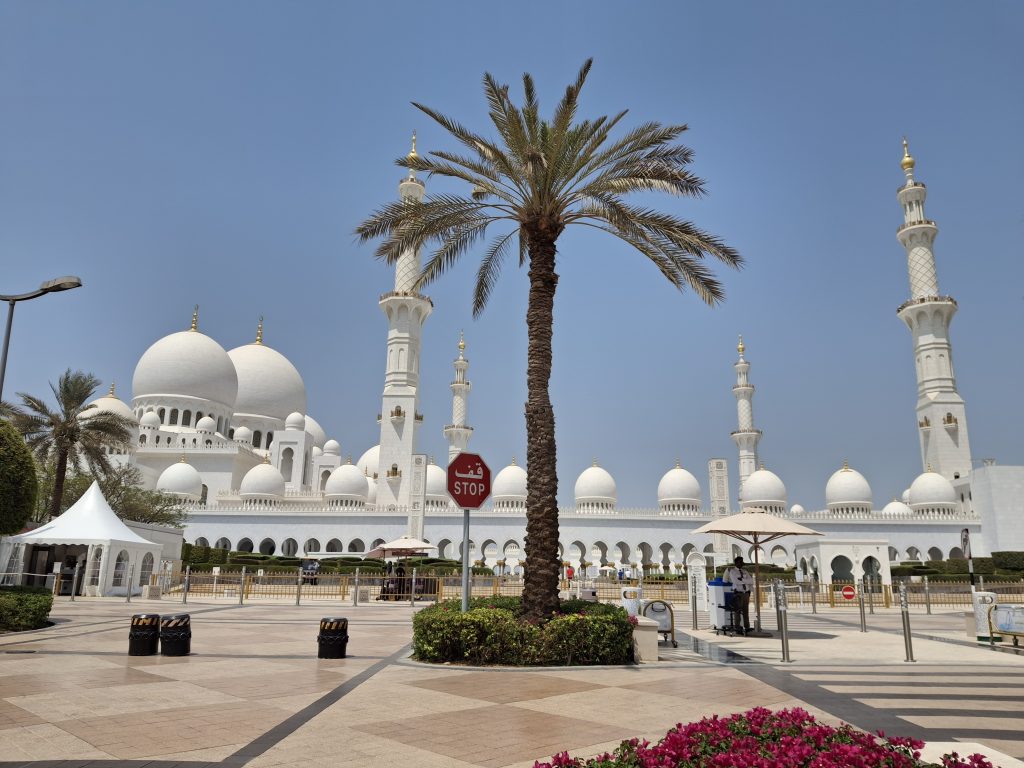If you’ve ever been to Abu Dhabi, the Sheikh Zayed Grand Mosque should definitely be on your checklist. Visiting the mosque under the scorching heat typical of the UAE, you will find a stunning white marble structure featuring 82 large domes and tall minarets set against a clear blue sky. In the evening, however, it offers a completely different and breathtaking view.
People from all over the world, regardless of religion, have access to this architectural marvel, which is named after the first UAE President, Sheikh Zayed bin Sultan Al Nahyan, who was buried in the mosque’s courtyard in 2004.
While Muslims come here for prayers, the mosque is also open to non-Muslims to admire its intricate interior. Visitors, particularly Western women, must follow a dress code and wear an abaya before entering.
You might even see toddlers sitting quietly and playing inside the mosque while their fathers are busy performing the Isha prayer. You may hear them crying loudly when they don’t get their father’s attention. Yet, no one expresses any annoyance or irritation.
The mosque stands as a perfect example of the multicultural unity the country is known for today. If you visit Abu Dhabi for the first time and walk through any street, you will encounter people from South Asia, Western expatriates, and other Arab countries. You are less likely to meet native Emiratis, as they make up roughly 10 to 15 per cent of the population.
Fun fact is that about 85 to 95 per cent of Abu Dhabi’s population are expatriates, making it a truly global city.
Much like the capital city itself, the Grand Mosque embodies a bond between many cultures. Standing tall on 30 acres of land between the three main bridges that connect Abu Dhabi city to the mainland, it symbolises the unity of multicultural collaboration.
Over 40 countries contributed materials and craftsmanship, making it a truly global project. Construction began in 1996 and took about 12 years, completing in 2007. Marbles were brought from Italy, Greece, and Macedonia. The mosque of 1,096 columns can accommodate 40,000 worshippers at a time.
The interior beauty is breathtaking. The main prayer hall houses a carpet from Iran, covering about 5,627 square meters. This is the world’s largest hand-knotted carpet, weighing 35 tons, with subtle raised lines woven in to help worshippers form perfectly straight rows during prayer. It was designed by Ali Khaliqi, an Iranian artist, and woven by about 1,200 to 1,300 artisans over two years.
The chandeliers, adorned with Swarovski crystals, originated from Germany and Austria, while the inlay stones from India dazzle the eyes with intricate detail. Although the chandeliers look massive, many of their golden parts are made with thin 24-carat gold-plated layers to reduce weight. One record-breaking chandelier in the main prayer hall is among the largest in the world, weighing about 12 tonnes.
The mosque also incorporates remarkable science. Its unique lighting system changes colours according to the phases of the moon, appearing bluish at a full moon and darker as it wanes. The white marble exterior was chosen not only for its beauty but also for its ability to keep the mosque cooler under the desert sun.
Art plays a central role in the mosque. You can find calligraphy inside the Sheikh Zayed Grand Mosque, as well as on exterior walls, featuring Qur’anic verses. Inside, the most striking calligraphy is on the Qibla Wall, the main wall facing Mecca. It features the 99 names of Allah (Asma Ul-Husna) inscribed in Kufic script, highlighted with elegant fibre-optic lighting that glows subtly at night.
The domes, mihrab, minarets, arches, and interior walls also feature calligraphic inscriptions from the Qur’an, highlighted in gold mosaic. The overall design is inspired by different Islamic architectural styles, including the Mughal dynasty of India, Egyptian Mamluk culture, and Ottoman influences from Turkey.
The Sheikh Zayed Grand Mosque is not only a place of worship but also a symbol of unity and global craftsmanship, a testament to history and heritage, bringing people together under the peaceful teachings of Islam.


